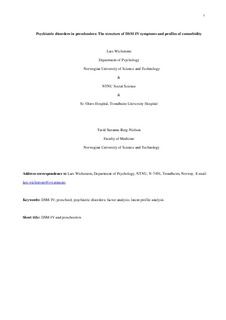| dc.contributor.author | Wichstrøm, Lars | |
| dc.contributor.author | Berg-Nielsen, Turid Suzanne | |
| dc.date.accessioned | 2019-07-17T11:03:19Z | |
| dc.date.available | 2019-07-17T11:03:19Z | |
| dc.date.created | 2013-11-13T16:22:42Z | |
| dc.date.issued | 2014 | |
| dc.identifier.citation | European Child and Adolescent Psychiatry. 2014, 23 (7), 551-562. | nb_NO |
| dc.identifier.issn | 1018-8827 | |
| dc.identifier.uri | http://hdl.handle.net/11250/2605650 | |
| dc.description.abstract | Psychiatric disorders have been increasingly recognized in preschool children; at present, however, we know comparatively less about how well current diagnostic manuals capture the symptoms described in this age group and how comorbidity is patterned. Therefore, this study aimed to investigate whether the symptoms defined by the Diagnostic and Statistical Manual of Mental Disorders, fourth edition (DSM-IV) load on their respective disorders, examine whether individual symptoms exist that load particularly high or low on the disorder they allegedly define, and analyze how comorbidity clusters in individual children. Parents of a community sample of Norwegian 4-year-olds (N = 995) were interviewed using the Preschool Age Psychiatric Assessment. A confirmatory factor analysis (CFA) and a latent profile analysis (LPA) were performed on the symptoms of seven DSM disorders: attention-deficit/hyperactivity disorder (ADHD), oppositional defiant disorder, conduct disorder, major depressive disorder (MDD), generalized anxiety disorder (GAD), social phobia, and separation anxiety disorder. The results showed that the CFA solution that closely resembled the disorders delineated in the DSM-IV fitted the data best. However, vegetative symptoms did not define preschool depression. The LPA identified nine symptom profiles among preschoolers, of which four showed evidence of psychopathology: comorbid MDD/GAD + ADHD combined type, comorbid MDD/GAD + ADHD hyperactive/impulsive type, separation anxiety only, and social phobia only. In conclusion, the symptoms observed in preschoolers fit the DSM-IV well, and comorbidity followed specific patterns. | nb_NO |
| dc.language.iso | eng | nb_NO |
| dc.publisher | Springer | nb_NO |
| dc.title | Psychiatric disorders in preschoolers: the structure of DSM-IV symptoms and profiles of comorbidity | nb_NO |
| dc.type | Journal article | nb_NO |
| dc.type | Peer reviewed | nb_NO |
| dc.description.version | acceptedVersion | nb_NO |
| dc.source.pagenumber | 551-562 | nb_NO |
| dc.source.volume | 23 | nb_NO |
| dc.source.journal | European Child and Adolescent Psychiatry | nb_NO |
| dc.source.issue | 7 | nb_NO |
| dc.identifier.doi | 10.1007/s00787-013-0486-7 | |
| dc.identifier.cristin | 1065352 | |
| dc.description.localcode | © Springer-Verlag Berlin Heidelberg 2013. This is a post-peer-review, pre-copyedit version of the article. The final authenticated version is available online at: http://dx.doi.org/ 10.1007/s00787-013-0486-7 | nb_NO |
| cristin.unitcode | 194,67,40,0 | |
| cristin.unitcode | 194,65,35,5 | |
| cristin.unitname | Institutt for psykologi | |
| cristin.unitname | RKBU Midt-Norge - Regionalt kunnskapssenter for barn og unge - psykisk helse og barnevern | |
| cristin.ispublished | true | |
| cristin.fulltext | preprint | |
| cristin.qualitycode | 2 | |
